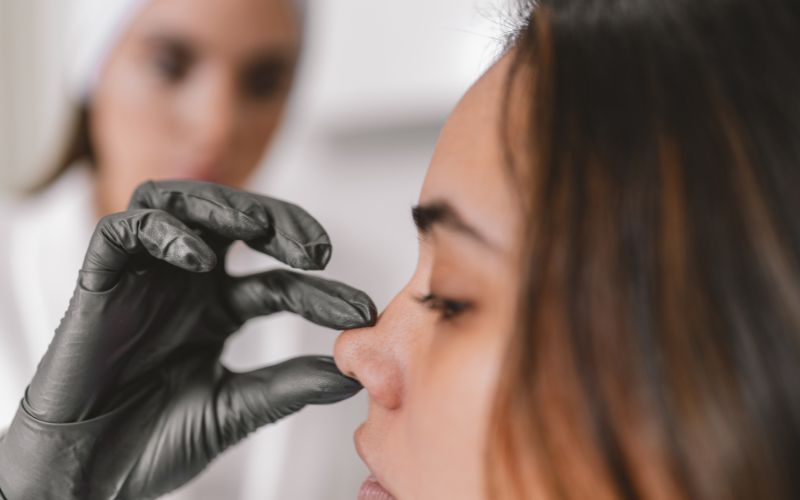What if you can get that perfect nose shape without any surgery? Read on for more details. Rhinoplasty, commonly known as a ‘nose job’ in Singapore is a surgical procedure done on one’s nose to enhance its shape or improve its function.
Contrary to the popular notion that it is purely a cosmetic procedure, rhinoplasty may be done for reasons other than that too. For instance, a deviated nasal septum is a medical condition that might require such surgery for rectifying breathing issues, or disfigurement of the nose. These may occur due to certain traumatic events that might also require surgical help.
However, surgical rhinoplasty is not your only option anymore.
The fairly less major nose concerns such as smoothening of certain bumps or trying to make it more angular etc. can easily be accomplished by a non-surgical nose enhancement: Nose Filler or Nose Thread.
What Is A Non-Surgical Nose Job?
A non-surgical nose job is a procedure that employs dermal fillers or threads that change the shape of one’s nose and provide the desired results without any surgery.
They are sometimes referred to as ‘liquid nose job’ or ‘the minute nose job’, as they take barely 10 to 15 minutes. The results usually last for 18 months.
Why Is Non-Surgical Nose Job Getting More Popular?
Benefits of Non-Surgical Nose Job vs. Traditional Surgical Procedure
- Less time consuming
- Lower cost
- End result is often more natural
- No downtime. One can easily go back to their work and perform daily activities on the same day
- The filler or threads eventually metabolize and there is no permanent disfigurement if the desired results were not achieved.
- The procedure does not require general anaesthesia (GA). Generally speaking each GA has 1% risk of severe side effect including death.
Nose Fillers
Nose fillers are used by doctors, to enhance the structure of the nose. For example- making it thicker, more upturned, etc. The best part is that the process does not even require a scalpel, let alone an operation theatre.
Usually, Hyaluronic Acid (HA) is used as a filler ingredient, underneath the skin to sculpt the nose.
Nose Threads
Popularly known as ‘Hiko Nose Lift’ or ‘lunchtime nose job’ owing to its almost timeless procedure and recovery, nose threading is done by inserting tiny strings of polydioxanone (PDO) threads through the tip of the nose.
This is of great use in the non-surgical procedures when the attempt made is to:
- Straighten the bridge of the nose
- Lift its tip
- Or to refine the bridge
How Do Nose Fillers & Nose Thread Differ?
We have so far established that both the nose fillers as well as the nose threads are actively used in aesthetic medicine to achieve the desired nose goals.
Usually, they are used individually, but occasionally, they are administered as a combined procedure as well. Their functions, however, differ.
Nose fillers are employed in cases where the nose requires a volume boost thereby enhancing the height of the bridge. Nose threads on the other hand, are used for contouring purposes per se, helping in providing that perfect lift, more sharpness, and definition to the nose.
Which Is More Suitable For Me?
Having learnt about the mechanism employed in modern aesthetic medicine these days to augment one’s nose, there might remain a doubt amongst many when it comes to choosing the right procedure for them.
The first step should be to meet the doctor. The doctor will analyze the anatomy of your nose and after having a detailed discussion, would recommend a procedure best suited to your requirements.
Fillers are recommended in cases requiring precise rectification of any bumpy defects, or work related to adjusting the height and volume of the nose’s bridge or tip. Threads are used for more rigid treatments and provide excellent results in cases requiring definition and tip projection.
Are These Procedures Safe?
Now that we know all that we need to, about the non-surgical nose procedures, the only concern that remains is regarding their safety.
The answer is yes! These procedures are completely safe.
Unlike surgical treatments, these procedures have a reduced risk of any blood vessels being damaged or disturbed. Also, since the procedure lasts only for 18 months, there is minimal risk of permanent damage.
The threads in many cases, also aid in natural collagen production, which helps in adding furthermore firmness and structure to the nasal area concerned.
The only caution one needs to take in this case is to choose the clinic and medical practitioner wisely, because the risk of procedure will be greatly reduced in a proper medical facility and qualified doctor.
And as per the rest, you are good to go!
When To See Best Results of Nose Fillers & Nose Thread?
As mentioned above, getting nose fillers or threads is a simple, quick, and easy process. However, it can take time for the best result to show. Generally, nose filler takes 1 week and nose thread takes 1 month to show their best result. It is important to follow up with your doctor 1 week after the procedure to make sure no complication has occurred such as infection.
You might experience temporary mild swelling which should subside by 2-3 days. Any prolonged swelling should be feedback to the clinic. Ready for a nose job in Singapore? Contact us at Kowayo Aesthetic Clinic for a consultation


